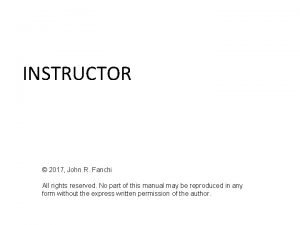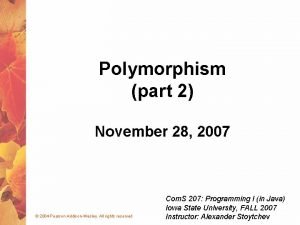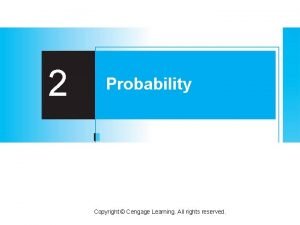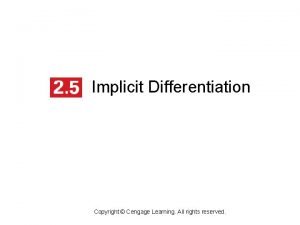3 Matrices Copyright Cengage Learning All rights reserved









![Matrix Addition and Scalar Multiplication (1 of 3) If A = [aij] and B Matrix Addition and Scalar Multiplication (1 of 3) If A = [aij] and B](https://slidetodoc.com/presentation_image/24a720f7b49015392492bb5247e4f417/image-10.jpg)




































![Example 3. 14 Let and C = [5, − 1, 2] Then their transposes Example 3. 14 Let and C = [5, − 1, 2] Then their transposes](https://slidetodoc.com/presentation_image/24a720f7b49015392492bb5247e4f417/image-47.jpg)


- Slides: 49

3 Matrices Copyright © Cengage Learning. All rights reserved.

3. 1 Matrix Operations Copyright © Cengage Learning. All rights reserved.

Matrix Operations (1 of 5) Definition A matrix is a rectangular array of numbers called the entries, or elements, of the matrix. The size of a matrix is a description of the numbers of rows and columns it has. A matrix is called m × n (pronounced “m by n”) if it has m rows and n columns. A 1 × m matrix is called a row matrix (or row vector), and an n × 1 matrix is called a column matrix (or column vector). 3

Matrix Operations (2 of 5) We use double-subscript notation to refer to the entries of a matrix A. The entry of A in row i and column j is denoted by aij. With this notation, a general m × n matrix A has the form 4

Matrix Operations (3 of 5) If the columns of A are the vectors a 1, a 2, . . . , an, then we may represent A as A = [a 1 a 2. . . an] If the rows of A are A 1, A 2, . . . , Am, then we may represent A as 5

Matrix Operations (4 of 5) The diagonal entries of A are a 11, a 22, a 33, . . . , and if m = n (that is, if A has the same number of rows as columns), then A is called a square matrix. A square matrix whose nondiagonal entries are all zero is called a diagonal matrix. A diagonal matrix all of whose diagonal entries are the same is called a scalar matrix. If the scalar on the diagonal is 1, the scalar matrix is called an identity matrix. 6

Matrix Operations (5 of 5) Two matrices are equal if they have the same size and if their corresponding entries are equal. Thus, if A = [aij]m × n and B = [bij]r × s, then A = B if and only if m = r and n = s and aij = bij for all i and j. 7

Example 3. 1 Consider the matrices Neither A nor B can be equal to C (no matter what the values of x and y), since A and B are 2 × 2 matrices and C is 2 × 3. However, A = B if and only if a = 2, b = 0, c = 5, and d = 3. 8

Matrix Addition and Scalar Multiplication 9
![Matrix Addition and Scalar Multiplication 1 of 3 If A aij and B Matrix Addition and Scalar Multiplication (1 of 3) If A = [aij] and B](https://slidetodoc.com/presentation_image/24a720f7b49015392492bb5247e4f417/image-10.jpg)
Matrix Addition and Scalar Multiplication (1 of 3) If A = [aij] and B = [bij] are m × n matrices, their sum A + B is the m × n matrix obtained by adding the corresponding entries. Thus, A + B = [aij + bij] If A and B are not the same size, then A + B is not defined. 10

Example 3. 3 Let Then but neither A + C nor B + C is defined. 11

Matrix Addition and Scalar Multiplication (2 of 3) If A is an m × n matrix and c is a scalar, then the scalar multiple c. A is the m × n matrix obtained by multiplying each entry of A by c. More formally, we have c. A = c[aij] = [caij] The matrix (− 1)A is written as −A and called the negative of A. We can use this fact to define the difference of two matrices: If A and B are the same size, then A − B = A + (−B) 12

Matrix Addition and Scalar Multiplication (3 of 3) A matrix all of whose entries are zero is called a zero matrix and denoted by O or Om×n. If A is any matrix and O is the zero matrix of the same size, then A+O=A=O+A and A − A = O = −A + A 13

Matrix Multiplication 14

Matrix Multiplication (1 of 6) Definition If A is an m × n matrix and B is an n × r matrix, then the product C = AB is an m × r matrix. The (i, j) entry of the product is computed as follows: cij = ai 1 b 1 j + ai 2 b 2 j +. . . + ainbnj • Notice that A and B need not be the same size. However, the number of columns of A must be the same as the number of rows of B. 15

Matrix Multiplication (2 of 6) The number of rows of AB is the same as the number of rows of A, while the number of columns of AB is the same as the number of columns of B, as shown below: 16

Matrix Multiplication (3 of 6) • The (i, j) entry of the matrix AB is the dot product of the ith row of A and the jth column of B: 17

Matrix Multiplication (4 of 6) Notice that, in the expression cij = ai 1 b 1 j + ai 2 b 2 j +. . . + ainbnj, the “outer subscripts” on each ab term in the sum are always i and j whereas the “inner subscripts” always agree and increase from 1 to n. We see this pattern clearly if we write cij using summation notation: 18

Example 3. 6 (1 of 3) Compute AB if Solution: Since A is 2 × 3 and B is 3 × 4, the product AB is defined and will be a 2 × 4 matrix. The first row of the product C = AB is computed by taking the dot product of the first row of A with each of the columns of B in turn. 19

Example 3. 6 (2 of 3) Thus, c 11 = 1(− 4) + 3(5) + (− 1) = 12 c 12 = 1(0) + 3(− 2) + (− 1)(2) = − 8 c 13 = 1(3) + 3(− 1) + (− 1)(0) = 0 c 14 = 1(− 1) + 3(1) + (− 1)(6) = − 4 The second row of C is computed by taking the dot product of the second row of A with each of the columns of B in turn: c 21 = (− 2)(− 4) + (− 1)(5) + (1)(− 1) = 2 20

Example 3. 6 (3 of 3) c 22 = (− 2)(0) + (− 1)(− 2) + (1)(2) = 4 c 23 = (− 2)(3) + (− 1) + (1)(0) = − 5 c 24 = (− 2)(− 1) + (− 1)(1) + (1)(6) = 7 Thus, the product matrix is given by 21

Matrix Multiplication (5 of 6) Every linear system can be written in the form Ax = b. In for the augmented matrix of a linear fact, the notation system is just shorthand for the matrix equation Ax = b. There is another fact about matrix operations that will also prove to be quite useful: Multiplication of a matrix by a standard unit vector can be used to “pick out” or “reproduce” a column or row of a matrix. 22

Matrix Multiplication (6 of 6) Theorem 3. 1 Let A be an m × n matrix, ei a 1 × m standard unit vector, and ej an n × 1 standard unit vector. Then a. ei A is the ith row of A and b. Aej is the jth column of A. 23

Partitioned Matrices 24

Partitioned Matrices (1 of 8) It will often be convenient to regard a matrix as being composed of a number of smaller submatrices. By introducing vertical and horizontal lines into a matrix, we can partition it into blocks. Consider the matrix 25

Partitioned Matrices (2 of 8) It seems natural to partition A as where I is the 3 × 3 identity matrix, B is 3 × 2, O is the 2 × 3 zero matrix, and C is 2 × 2. In this way, we can view A as a 2 × 2 matrix whose entries are themselves matrices. 26

Partitioned Matrices (3 of 8) When matrices are being multiplied, there is often an advantage to be gained by viewing them as partitioned matrices. Suppose A is m × n and B is n × r, so the product AB exists. If we partition B in terms of its column vectors, as then 27

Partitioned Matrices (4 of 8) This result is an immediate consequence of the definition of matrix multiplication. The form on the right is called the matrix-column representation of the product. 28

Partitioned Matrices (5 of 8) Suppose A is m × n and B is n × r, so the product AB exists. If we partition A in terms of its row vectors, as Then 29

Partitioned Matrices (6 of 8) Once again, this result is a direct consequence of the definition of matrix multiplication. The form on the right is called the row-matrix representation of the product. The definition of the matrix product AB uses the natural partition of A into rows and B into columns; this form might well be called the row-column representation of the product. We can also partition A into columns and B into rows; this form is called the column-row representation of the product. 30

Partitioned Matrices (7 of 8) In this case, we have so (2) 31

Partitioned Matrices (8 of 8) Notice that the sum resembles a dot product expansion; the difference is that the individual terms are matrices, not scalars. Each term ai. Bi is the product of an m × 1 and a 1 × r matrix. Thus, each ai. Bi is an m × r matrix—the same size as AB. The products ai. Bi are called outer products, and (2) is called the outer product expansion of AB. 32

Example 3. 12 (1 of 4) Consider the partitioned matrices A and B as follows. They have the block structures 33

Example 3. 12 (2 of 4) If we ignore for the moment the fact that their entries are matrices, then A appears to be a 2 × 2 matrix and B a 2 × 3 matrix. Their product should thus be a 2 × 3 matrix given by But all of the products in this calculation are actually matrix products, so we need to make sure that they are all defined. 34

Example 3. 12 (3 of 4) A quick check reveals that this is indeed the case, since the numbers of columns in the blocks of A (3 and 2) match the numbers of rows in the blocks of B. The matrices A and B are said to be partitioned conformably for block multiplication. Carrying out the calculations indicated gives us the product AB in partitioned form: 35

Example 3. 12 (4 of 4) The calculations for the other five blocks of AB are similar. Check that the result is 36

Matrix Powers 37

Matrix Powers (1 of 2) When A and B are two n × n matrices, their product AB will also be an n × n matrix. A special case occurs when A = B. as and, in general, to define To define if k is a positive integer. Thus, and it is convenient to define 38

Matrix Powers (2 of 2) The following properties follow immediately from the definitions. If A is a square matrix and r and s are nonnegative integers, then 39

Example 3. 13 (1 of 5) (a) If then and, in general, The above statement can be proved by mathematical induction, since it is an infinite collection of statements, one for each natural number n. 40

Example 3. 13 (2 of 5) The basis step is to prove that the formula holds for n = 1. In this case, as required. The induction hypothesis is to assume that for some integer k ≥ 1. The induction step is to prove that the formula holds for n = k + 1. 41

Example 3. 13 (3 of 5) Using the definition of matrix powers and the induction hypothesis, we compute Thus, the formula holds for all n ≥ 1 by the principle of mathematical induction. 42

Example 3. 13 (4 of 5) (b) If then Continuing, we find and 43

Example 3. 13 (5 of 5) and the sequence of powers of B repeats in Thus, a cycle of four: 44

The Transpose of a Matrix 45

The Transpose of a Matrix (1 of 3) Definition The transpose of an m × n matrix A is the n × m matrix obtained by interchanging the rows and columns of A. That is, the ith column of is the ith row of A for all i. 46
![Example 3 14 Let and C 5 1 2 Then their transposes Example 3. 14 Let and C = [5, − 1, 2] Then their transposes](https://slidetodoc.com/presentation_image/24a720f7b49015392492bb5247e4f417/image-47.jpg)
Example 3. 14 Let and C = [5, − 1, 2] Then their transposes are 47

The Transpose of a Matrix (2 of 3) A useful alternative definition of the transpose is given componentwise: In words, the entry in row i and column j of as the entry in row j and column i of A. is the same 48

The Transpose of a Matrix (3 of 3) The transpose is also used to define a very important type of square matrix: a symmetric matrix. Definition A square matrix A is symmetric if equal to its own transpose. = A—that is, if A is A symmetric matrix has the property that it is its own “mirror image” across its main diagonal. A square matrix A is symmetric if and only if Aij = Aji for all i and j. 49
 Copyright 2015 all rights reserved
Copyright 2015 all rights reserved Copyright © 2015 all rights reserved
Copyright © 2015 all rights reserved Dell all rights reserved copyright 2009
Dell all rights reserved copyright 2009 Copyright © 2018 all rights reserved
Copyright © 2018 all rights reserved Cengage chapter 7
Cengage chapter 7 All rights reserved example
All rights reserved example All rights reserved sentence
All rights reserved sentence Freesound content licence
Freesound content licence Confidential all rights reserved
Confidential all rights reserved Sentinel value
Sentinel value Pearson education inc all rights reserved
Pearson education inc all rights reserved Microsoft corporation. all rights reserved.
Microsoft corporation. all rights reserved. Microsoft corporation. all rights reserved.
Microsoft corporation. all rights reserved. Microsoft corporation. all rights reserved.
Microsoft corporation. all rights reserved. Pearson education inc. all rights reserved
Pearson education inc. all rights reserved Warning all rights reserved
Warning all rights reserved All rights reserved c
All rights reserved c All rights reserved formula
All rights reserved formula Warning all rights reserved
Warning all rights reserved Confidential all rights reserved
Confidential all rights reserved Microsoft corporation. all rights reserved
Microsoft corporation. all rights reserved 2010 pearson education inc
2010 pearson education inc Gssllc
Gssllc Copyright 2010 pearson education inc
Copyright 2010 pearson education inc Pearson education inc. all rights reserved
Pearson education inc. all rights reserved Confidential all rights reserved
Confidential all rights reserved Airbus deutschland gmbh
Airbus deutschland gmbh Matrices formula
Matrices formula R rights reserved
R rights reserved Rights reserved
Rights reserved 2009 delmar cengage learning
2009 delmar cengage learning Medical terminology chapter 5 learning exercises answers
Medical terminology chapter 5 learning exercises answers Cengage learning heart diagram
Cengage learning heart diagram South-western cengage learning
South-western cengage learning 2009 delmar cengage learning
2009 delmar cengage learning 2009 delmar cengage learning
2009 delmar cengage learning Cengage learning heart diagram
Cengage learning heart diagram Medical terminology chapter 1 answers
Medical terminology chapter 1 answers Cengage learning australia
Cengage learning australia 2009 delmar cengage learning
2009 delmar cengage learning Cengage learning
Cengage learning Cengage learning
Cengage learning Wadsworth cengage learning
Wadsworth cengage learning Cengage learning
Cengage learning Cengage learning plant cell
Cengage learning plant cell Cengage learning
Cengage learning Cengage learning
Cengage learning Brooks cole cengage learning
Brooks cole cengage learning Chapter 7:10 respiratory system
Chapter 7:10 respiratory system 2014 cengage learning accounting answers
2014 cengage learning accounting answers








































































